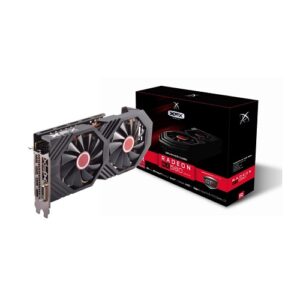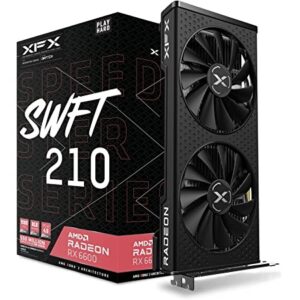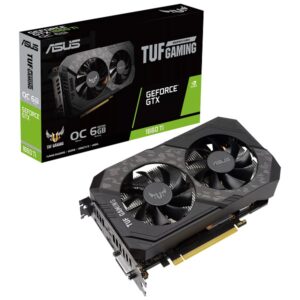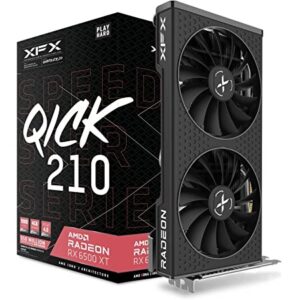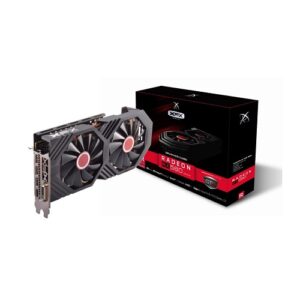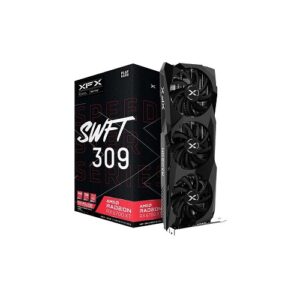Product Details
MSI GeForce RTX 2080 Duke 8GB
- 1515 MHz Core – Boostable to 1710 MHz
- 2944 CUDA Cores
- Turing Architecture
- 8GB of GDDR6 VRAM
- 14 Gb/s Memory Speed
- 256-Bit Memory Interface
- DisplayPort 1.4 | HDMI 2.0b | USB Type-C
- 7680 x 4320 Max Digital Resolution
- Triple TORX 2.0 Fans | RGB Mystic Light
- VirtualLink Ready
Description
Based on the Turing architecture and designed to handle the graphical demands of 4K gaming, the MSI GeForce RTX 2080 DUKE Graphics Cardbrings the power of real-time ray tracing and AI to your PC games. It also features enhanced technologies to improve the performance of VR applications, including Variable Rate Shading, Multi-View Rendering, and VRWorks Audio.
The front panel of the card features a variety of outputs. There are three DisplayPort 1.4 outputs, one HDMI 2.0b output, and one USB Type-C port with the VirtualLink standard. The RTX 2080 is not just about high-resolution gaming. Computationally intensive programs can utilize the GPU’s 2944 cores to accelerate tasks using CUDA or other APIs.
For cooling, MSI implemented dual TORX 2.0 fans. This GPU also utilizes MSI ZeroFrozr technology to eliminate fan noise by stopping the fans in low-load situations. With RGB Mystic Light, you can customize colors and LED effects with exclusive MSI software and synchronize the look and feel with other MSI components.
- Real-Time Ray Tracing
- The NVIDIA GeForce RTX platform enables real-time ray tracing of objects and environments with physically accurate shadows, reflections, refractions, and global illumination. The RTX 2080 features 8 GigaRays per second and up to 57T RTX-OPS*.
*Equivalent aggregate math operations contributed by the Turing Shaders, CUDA Cores, Tensor Cores, and RT Cores needed to render RTX graphics.
- USB Type-C with VirtualLink
- VirtualLink is an open industry standard that enables next-gen VR headsets to connect with PCs and other devices using a single, high-bandwidth USB Type-C connector. The Alternate Mode of USB Type-C simplifies and speeds up VR setup time, avoiding key obstacles to VR adoption. VirtualLink connects with VR headsets to simultaneously deliver four high-speed HBR3 DisplayPort lanes, which are scalable for future uses, a USB 3.1 Gen 2 data channel for supporting high-resolution cameras and sensors, and provides up to 27 watts of power.
- SLI Ready
- With a compatible motherboard and a connecting bracket, two or more NVIDIA GPUs of the same model can combine processing power using NVIDIA’s Scalable Link Interface (SLI). How the cards work together can be customized to suit your preferences. Alternate frame rendering has each alternating card prepare the next frame, essentially multiplying the capabilities of a single card’s maximum capable frame rate output. Each card in the configuration can also be used to improve anti-aliasing by being able to process an image in parallel with the other cards before filtering out jagged edges.
The NVIDIA GeForce RTX NVLink Bridge (sold separately) provides 50 times the available transfer bandwidth of previous technologies. Delivering smooth gameplay, it’s an effective way to enjoy surround gaming and it’s only compatible with the GeForce RTX 2080 and 2080 Ti graphics cards.
Note: The benefits of SLI will vary based on component configuration.
- NVIDIA GPU Boost 4.0
- Boosts the card’s clock speed in real-time based on the target temperature. If the card is running below the set target temperature, GPU Boost 4.0 will increase the clock speed to improve performance. The target temperature can be reset depending on your preference so you can have the card run more quietly for everyday tasks and older games, and run at full tilt during intense high-resolution gaming sequences.
- NVIDIA Ansel
- With Ansel, gamers can compose the gameplay shots they want, pointing the camera in any direction and from any vantage point within a gaming world. They can capture screenshots at up to 32 times the screen resolution, and then zoom in where they choose without losing fidelity. With photo-filters, they can add effects in real-time before taking the shot. And they can capture 360-degree stereo photospheres for viewing in a VR headset or Google Cardboard.
- CUDA
- NVIDIA’s parallel computing platform which enables an increase in computing performance by harnessing the parallel nature of GPU processing. CUDA-compatible applications can assign intensive parallel computing tasks, such as real-time video rendering, to the GPU to process, freeing up the computer’s CPU to run other tasks.
- G-SYNC Ready
- When used with a monitor that has G-SYNC hardware installed, the monitor’s refresh rate will sync and lock with the graphics card’s output frame rate. Establishing this sync removes tearing and stuttering which can result from conventional fixed screen refresh rates, especially important for gaming in stereoscopic 3D. An additional benefit of G-SYNC is reduced lag so gamers will benefit from the improved command response time as well.


